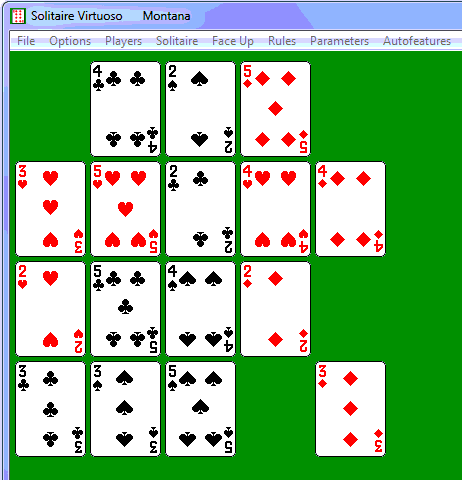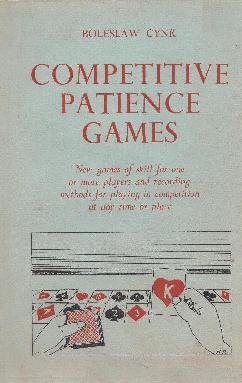Montana (Gaps) Solitaire

A popular solitaire with a number of variants is usually
called
Montana or Gaps. In the standard form of this solitaire, the
entire
deck is dealt into four rows, nonoverlapped, or thirteen cards
each.
The four aces are removed, and take no further part in play. The
empty spaces remain (hence the common name Gaps). The
object is to arrange the cards into four rows, one in each suit,
running from twos at the far left to kings at the right, with gaps at
the far right end. Only one kind of move is permitted: a
card may be
moved into an empty space if it is the same suit and one higher in rank
than the card to its left. In the diagram above (showing the
start of Virtuoso deal 71830), the gap
in row 1 may be
filled with the king of
hearts near the end of row 2, leaving a new gap behind the six of
hearts. Other
cards which could be moved are the three of hearts, jack of clubs, and
jack of spades. A space at the far left of a row may be filled
with any
two, even a two already at the start of a row (which may have cards of
the same suit in sequence behind it). This means that the suit
being built in each row is not permanently established, and may be
changed until all four twos are placed (this is critically important in
playing miniature versions, as we will see below). Nothing
can be moved behind a king, so a gap of one or more spaces behind a
king are blocked unless
we can move that king later. Gradually you
want to build
continuous sequences in each suit as far as possible. It is
usually
very difficult to finish all four suits before
being blocked by having all four gaps behind kings. Most versions
allow the game to be continued after the player is blocked, by using a
redeal in which all of the cards not in sequence from the left end of
each row are taken up and shuffled, and dealt row-by row, leaving a gap
behind the last card in sequence in each row.
The deal above is the first time I have ever won on the initial deal, though it took two tries. On my first attempt, I made several series of undos, ending with
two cards (queen and king of diamonds) blocked at the end. I started
over, and found that by making several changes of suit in the top three
rows, I was able to finally make the deal come out on the first pass, by moving the following cards in sequence:
KH 7H 7S KD 8D 6D 8H 6H JS 3H
4H 7C JC TS QC QS 9D TD 7H JD
9S 8S 2D3 3D 8H QD 9C 2H4 3H 4H
5H 2S2 3S QH KH 7D 8D 8C 9C 5C
6C 9H 6H 4S 9D TC 6S TS 9S 4D
2D1 3D 4D 2S3 3S 4S 2C2 JH TD JC
7S 3C 4C TS 5S 6S 7H 8H 5C JS
KC 6C QS 5D 6D 7D 8D 9D TD JD
QC QD KC 8S 9S TS 7S 9H 7C 8C
9C TC JC QC 8S 9S TH JS TS JH
QS QH KD JS QS KC KH
Montana is a popular game found very often in both
books and computer
implementations. Some versions restrict the player to two or
three redeals; others allow an unlimited number of redeals (of course,
a deal will always come out eventually if redeals are
unlimited). The deal above was my first win with no
redeals; I had previously won once on the first redeal, and
occasionally within four
deals (three redeals).
Mark Masten has been investigating the game with his own computer solver.
It appears that Gaps is overwhelmingly harder for human players than
computers: his computer solver wins over 85% of deals on the first pass
under the rules we describe here, where a two of any suit can be played
to any row with an empty space at the left. Over 62% of deals can
be won without any suit changes (i.e. without moving a two from the
left end of one row to another). The variant with the suit
of each row preassigned has a much lower win rate, just under
25%. Mark's article has much more detail, including technical details on his solver.
The version in Solitaire Virtuoso allows unlimited redeals, and also
allows larger and smaller versions to be played by changing the number
of suits and ranks. Select either of these under the
Parameters menu. Clicking on a playable card sends it automatically to
the spot where it is allowed to go. Clicking on a two
normally sends it to the first available open spot at the left end of a
row; if more than one such spot is open, and you want to a send a two
to a spot other than the first, you may send it to the second available
spot by holding down the Shift key while clicking, or the third
available spot with Control + click. You can also send it
to the last available spot with a right-mouse click.
Clicking on the blue stockpile at any time reshuffles. Clicking
on the stock once the game is won automatically writes the full
solution to a text file with the prefix MON, followed by the deal
number. This can be edited by hand if you wish to add notes
on your solution. You also write a partially played game to
a file using Options/Write Solution, though as yet there is no playback
capability.
Reduced deck variants

Smaller versions are suitable to be played as open solitaires by not
allowing any redeals. I have played quite a few deals with
five ranks and four suits, winning about 70 percent of the time.
Professor N. G. de Bruijn wrote an article (see Bibliography) on the
four-rank version, which he calls Pretzel Solitaire, but he presets the
suit of each row by placing the aces to the left of the rows in the
fixed order S-H-D-C. He claims a win rate of about 45%, but in my
opinion much of the richness of strategy lies in choosing which suit to
build in each row, and frequently switching suits: playing a two to one
row and later to a different row. Above is a sample deal,
number 83002, with five ranks. I won by the sequence of
moves below: note that the twos of spades and diamonds were moved twice.
2S1 5C 3H 2D2 5S 4S 5S 4H 5H 3C
2S4 2D1 2C2 3C 4C 5C 3D 4D
A historical version with a reduced deck is House of Commons, found in Tarbart's 1905 second edition of Patience Games, and Mary Whitmore Jones' 1911 New Games of Patience (Parlett includes it in his 1979 Penguin Book of Patience).
It is played with the 40 cards from ace to ten of each suit, exactly as
the standard Montana, with one redeal allowed (the cards are not
shuffled, but picked up in order and redealt.)
Surprisingly, Mark Masten's solver says this is just slightly the
hardest game to win on the first pass, with a win rate a little under
82%.
Other variants
Boleslaw Cynk devoted an entire book to a set of original variants to
Gaps. All of his versions, rather than using the aces to
create random gaps, leave a space at the left end of each row, which
can be filled at any time with a two (or an ace in The Blue Moon
variant using the full deck). He also eliminated the
shuffling of cards between redeals: the out-of-order cards are picked
up from left to right (in each row from top to bottom), and redealt in
the same order, leaving a space after the correctly ordered sequence
(if any) in each row. He also created two new allowable
strategic moves: the row-exchange rule allows an equal number of cards of two rows (in correct sequence starting from the left end) to be exchanged; the ace-double role rule
allows an ace to be placed in a space behind the king of the same
suit. Using these rules, Cynk was able to successfully
solve every tableau sent to him by readers of Leisure
magazine with no more than two redeals (and most of them with only
one). His reduced-deck version Trains (twos through eights)
can usually be won without any redeals, using only the row-exchange
rule. Double Gaps is a full-deck version dealt into a
4x15 array, with two spaces at the left end of each row (aces and the
corresponding twos can be played to those spaces
immediately). Cynk estimates the win rate at 80% with no
redeals, sometimes without any row-exchanges.
Another notable variant is Robert Harbin's Spaces and Aces (Waddington's
Family Card Games, 1972), in which a gap may be filled with any higher
card of the same suit. In his version the aces are removed from
the 4x13 array and each placed at the left end of one of the rows
(forming a 4x14 array), fixing the suit of that row for the rest of the
deal. There is no redeal; this is a completely open
variation.

Bibliography
de Bruijn, N. G. -- Pretzel Solitaire as a Pastime for the Lonely
Mathematician, pp. 16-24 in The Mathematical Gardner (edited by David
A. Klarner), 1981, Wadsworth International/Van Nostrand Reinhold, ISBN
0-442-25336-2
Article on 4x4 Montana, with mathematical theory and many sample
deals. The author suggests playing deals out in your head before
you ever move a card.
Cynk, Boleslaw -- Competitive Patience Games, 1966, John Baker, 103pp., hardback
Robert Harbin, Waddington's Family Card Games, 1972, Elm Tree Books
(reprinted 1974 by Pan Books, ISBN 0-330-23892-2
Copyright ©2024 by Michael Keller.
All rights reserved. This file was revised on August 14, 2024


